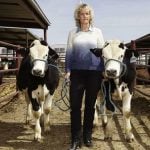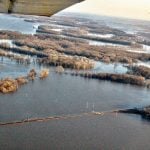I can’t remember when I’ve heard so many apologies. The farmers I’m calling are bright, committed, take-charge people, but when I ask them how the new federal-provincial program AgriStability is going to make a difference for their farm, they stumble.
As a group, they apologize for not understanding it better. They tell me they know they should be more up to speed on AgriStability. They also feel sure their neighbours must be much more on top of all things AgriStability than they are.
Read Also

Producers aren’t panicking over tariffs and trade threats
The Manitoba Canola Growers Association (MCGA) surveyed its members this spring to get a sense of how trade uncertainty was…
That’s where they’re wrong. I quickly and honestly tell them their response is indeed quite typical. Their neighbours don’t feel qualified to speak to me about AgriStability either. None of them feels they know enough about the program to say how it is going to fit into their management plans, or to venture an opinion about how well it’s going to work.
Sure, I say into the phone, there might be the odd keener who has taken a course on it or who has spent nights pouring over the details, but basically I tell the farmers I call that they represent “normal” farmers quite well. Their lack of understanding is shared by almost everyone. And then I hang up the phone and dial the next number on my list.
Jeff Gaab picks up the phone. Gaab farms 7,000 acres near Weyburn, Sask. with his wife Tally, brother Warren and his wife Peggy, and their respective families. They run crops ranging from wheat to canola and from mustard to flax.
Gaab too was reluctant to speak about AgriStability, but was convinced when assured that he didn’t need all the answers. Like most producers, he gets the basic premise: risk management.
The intent of the program, Gaab says, should be and is to “cover the hurt.” Gaab believes that in combination with provincial crop insurance, AgriStability will protect him against disastrous loss. Let’s hope so. This year in Saskatchewan, much of the crop was either not sowed due to excessive rain, or drowned out after the fact. It might just be the first real test of the program.
“You like to think you’re risk-proofing as much as possible,” Gaab says. “The first line of defence is crop insurance. It’s there and it’s responsive. If you have a disaster, you probably will find out within 60 days what you’ll be receiving.”
Running a year to 18 months behind, depending on fiscal year-end, AgriStability isn’t as responsive, Gaab says, but together the two programs “basically insure for cash flow. It seems to have changed (over the years) so that you need a flow of income throughout the year and these help to cover any financial strain.”
According to Shea Ferster, Gaab is managing his risk as well as possible. Ferster is farm income program service leader with Meyers Norris Penny in Saskatoon and he is an unabashed advocate of the AgriStability program. He is also discouraged by the naysayers. “It provides stability for an active, business-like farmer,” Ferster says. “It is risk management.”
Ferster says producers must enrol in the suite of programs including crop insurance, AgriInvest and AgriStability to manage their risk effectively. “The programs are designed to work together, but some don’t want to pay the premium.”
Crop insurance covers production loss, while AgriStability stabilizes income. No one seems quite able to tell me why AgriInvest exists, but it does allow producers to put away money in good years to help out in the bad.
As far as he can tell, Gaab feels the suite of business risk management tools is working on the farm. “Even in a low commodity price year you can keep cash flow by marketing into markets you don’t necessarily want to go into,” he says, meaning taking a lower price. “It keeps cash flow and then the programs help out after that.
“It’s not like you want to count on that,” Gaab emphasizes. “It’s just that I’d sooner make cash flow than let product sit in a bin and pay interest on an operating line.”
Gaab says their farm plan, like most, is a combination of agronomics and economics. He likes the fact AgriStability figures are based on his own farm operation history rather than area numbers. Fluctuating margins are, in a sense, actually necessary for the program to work, since a five-year average is used to determine margin and thus loss. “The good years should hold you through (a) down year,” Gaab says. “In a way it gives you a good backstop to do things. It allows you to use agronomic practices that put the risk where it should be.”
Again MNP’s Ferster agrees, saying changes have been made since the program was conceived to allow it to stabilize income, not make an unprofitable operation profitable. “The first rule of any program is you don’t want people to operate a business to gain government money… It can’t save everybody but that was never the intent.”
So if the intent is stabilizing income, will it work? According to David Sparling it will. “It definitely stabilizes and provides an additional revenue stream,” says Sparling, professor and chair of agri-food innovation and regulation, a newly formed department at Richard Ivey School of Business at the University of Western Ontario.
Sparling knows business and he knows farming. A poultry producer for 20 years, he ran a 40,000-bird operation while obtaining both his MBA and PhD before joining the academic world full time.
Crop insurance is relatively effective and responds quickly to what’s happening in the field, Sparling says, and it’s a good deal as far as premiums and coverage.
“AgriInvest is just kind of there,” Sparling says. “Essentially it’s a giveaway, basically a gift.”
AgriStability by contrast is more complex and the producer has to wait until their tax return is filed, so there is significant lag between when the loss occurs and when money is received.
“But it does kick in and support revenue. Government payments as a whole stabilize margins and support farm incomes,” Sparling says.
But while saying this, Sparling questions the entire focus of government support programs and whether a one-size- fits-all method is best for agriculture across the country. (See The large versus the small of it.)
Aside from questions of intent, a criticism of the program is that it’s simply too complicated for farmers to feel engaged in or to trust. MNP’s Ferster says too many producers, big or small, are just not interested in AgriStability.
“It’s a process of converting your sales activity into your production numbers,” Ferster says. “My experience is that it’s a really big educational opportunity for producers because there isn’t much interest in even knowing what their inventory numbers are.”
Ferster uses the example of a farmer with a 4,000-bushel bin. Each year he’s asked how much is in the bin and he always says 4,000 bushels because that’s the size of the bin. “But depending on the crop, the number will actually be different. It may not be a significant amount but if you’ve got over half a million in inventory and you’re five to 10 per cent out that amounts to $50,000.” And that’s significant.
Most producers fill out the application form, assemble the numbers and let Ferster do the rest. “The nuances of the program are what the average producer would struggle with,” he says.
But perhaps it is those nuances that create the lack of interest in the first place. It’s a moot point to Jeff Gaab who understands margin is determined based on taxable income, and eligible income and expenses are determined by the program. He still hands the whole thing over to his accountant.
“It’s another one of those things that needs somebody with expertise. You have to get the right professional people.” Gaab makes no apologies for this. And why should he? He’s already managing production, marketing and human resources. “It’s a cost. The accounting and bookkeeping involved in a significant operation is enough. But it’s part of life now,” Gaab says.
Does it have to be “part of life” for AgriStability? Some AgriStability advisers in Saskatchewan say no. Saskatchewan Crop Insurance took over administration of the program from the federal government in 2009. It’s administered provincially in B.C., Alberta and Ontario as well. AgriStability advisers are keen to tell producers that program changes have made the program a lot more farmer friendly. They can indeed do it themselves.
Advisers say it’s basically a question of getting the numbers together and transferring them to the form. Year-end inventory, accounts payable and receivable, purchased inputs, acres seeded and live cattle births about cover it for a standard farm. Corporations are a little trickier, but the numbers still come right off the tax form, so it can be done.
While advisers won’t actually fill out the form for you, they certainly create an element of understanding that has so far been lacking. Advisers deal with questions around calculation of benefits, progress of applications, and deadlines. Some producers question the eligible expenses, wondering why something like machinery repair wouldn’t be included. The best explanation I received was that when establishing reference margins, the program is designed to compare apples to apples. So only the expenses specifically related to production of the crop for that particular year are eligible.
If I can understand it, I’m pretty sure anyone can. Producers estimate they’re paying as much as $800 for preparation and administration of the AgriStability program by accountants. So the whole process might be worth a second look.
Still, there’s the opportunity cost. Is wrestling with the form really the best use of your time? “It’s hard to communicate with the program,” Jeff Gaab says. Inquiries and disputes come up over the evaluation or interpretation of the numbers. And it’s frustrating to challenge. His accountant has told him the federal bureaucracy has five accountants to Gaab’s one. He laughs, “They have the resources behind them to make their point.”
Most commercial farmers are enrolled in the government’s suite of business risk management programs by default. They are large operations, using all the risk management tools available. They have accountants to carry out the details, and the cost is absorbed into their operations relatively easily.
Ferster argues that size is irrelevant to the efficacy of AgriStability. “Size doesn’t matter. It comes back to management. If they’re interested and want to be a business, it will work.” He says he’s seen successes and failures, both large and small. His best managed client farm is 1,200 acres, small by Saskatchewan standards. Yet Ferster goes on to say the government definition of “farm” anything from a half section to 12,000 acres, is what skews the numbers and makes the program appear not to work.
So if those pesky small farms would just give it up, the program would work? Perhaps, according to the experts I spoke with.CG
———
While AgriStability advisers say you don’t need an accountant to fill out the forms, Jeff Gaab hired one. And he doesn’t apologize. “You have to get the right professional people.”














